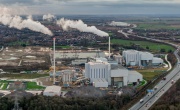WRAP publishes new carbon metric
CarbonWARM tool expands coverage to incorporate new waste streams, including WEEE, batteries, sanitary waste, and incinerator bottom ash.
 The Waste and Resources Action Plan (WRAP) has published an updated version of its Carbon Waste and Resources Metric (CarbonWARM) methodology, which provides a tool to assess the greenhouse gas impacts of waste management practices.
The Waste and Resources Action Plan (WRAP) has published an updated version of its Carbon Waste and Resources Metric (CarbonWARM) methodology, which provides a tool to assess the greenhouse gas impacts of waste management practices.
Developed by WRAP for the Department for Environment, Food and Rural Affairs (Defra), the metric aims to provide local authorities, waste managers and policymakers a robust method for quantifying the carbon impact of different disposal options in tonnes of carbon dioxide equivalent (CO2e) per tonne of material.
The accompanying report says it is ‘intended to supplement traditional weight-based monitoring and evaluation with an approach that focuses more on the environmental (climate) impacts of waste and resource management’.
The second version expands coverage to incorporate several new waste streams, including waste electrical and electronic equipment (WEEE), batteries, sanitary wastes, rubble, and incinerator bottom ash.
CarbonWARM2 also introduces territorial emissions calculations to quantify emissions based on the country in which goods and services are produced. The 2021 version quantified solely based on emissions of products consumed in the country, but produced overseas.
Territorial emissions calculations are used for national greenhouse gas emissions reporting as part of the Paris Agreement. However, the report acknowledges limitations in the available data: "For many materials, there is a lack of robust data on production, imports and exports to enable accurate calculation of territorial emissions. The values in this report should therefore be regarded as strictly indicative, with a wide potential margin of error."
The tool has been designed for several uses, including monitoring and reporting CO2e savings achieved by shifting waste management practices, evaluating how much potential CO2e savings have been realised through current practices, and comparing the greenhouse gas impacts of different waste management scenarios.
Metal recycling leads with most carbon saving benefits
The updated metric contains substantially expanded coverage of materials, and the report's results show significant variations in carbon impacts across different waste streams and treatment methods.
Metals show the most compelling recycling benefits in carbon terms, with aluminium recycling offering the highest carbon savings of any material.
The data for plastic illustrates why the waste hierarchy’s preference for recycling over energy recovery is particularly important for these materials. Although recycled rigid PET plastics provide a carbon benefit, sending the same material to energy from waste results in a carbon cost of +1.606 tonnes CO2e per tonne.
Organic waste treatment comparisons reveal that while food waste sent to landfill generates +0.696 tonnes CO2e per tonne, anaerobic digestion offers modest climate benefits at -0.062 tonnes CO2e per tonne, slightly outperforming composting at -0.055 tonnes CO2e per tonne.
Among the newly added waste streams, WEEE shows considerable variation in recycling benefits depending on the specific category, with large appliances like refrigerators offering higher carbon savings than small household appliances.
The report also demonstrates the carbon benefits or costs associated with different recycling systems. Closed loop recycling where materials were separated at source largely had greater benefits than open loop or commingled recycling streams.
WRAP has also developed a tool for retailers to calculate carbon footprint gain from textile repair and resale initiatives.




